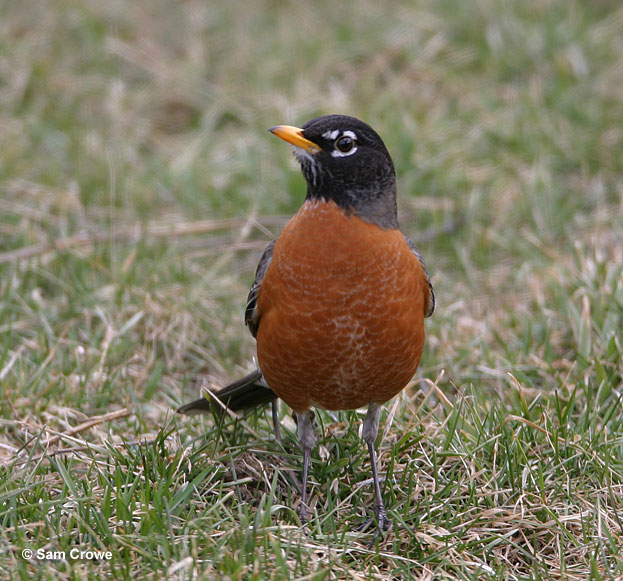
The birds of Connecticut form an impressive list of 421 species! In Connecticut, we find warblers, owls, and other birds in the woods, and aquatic species on the shores of Long Island Sound.
Connecticut has a lot of birds for its size! How many birds in Connecticut have you seen? How many could you identify?
The following list shows the most common backyard and wild birds in Connecticut!
On this page
Most common birds of Connecticut
According to eBird data from 2021 to 2023, these are the 30 most common birds of Connecticut.
To help identify these beautiful birds, we also included information about field marks and behavior (remember that the species on the bottom of the list are common birds too!).
The 30 Most common birds of Connecticut
Northern Cardinal
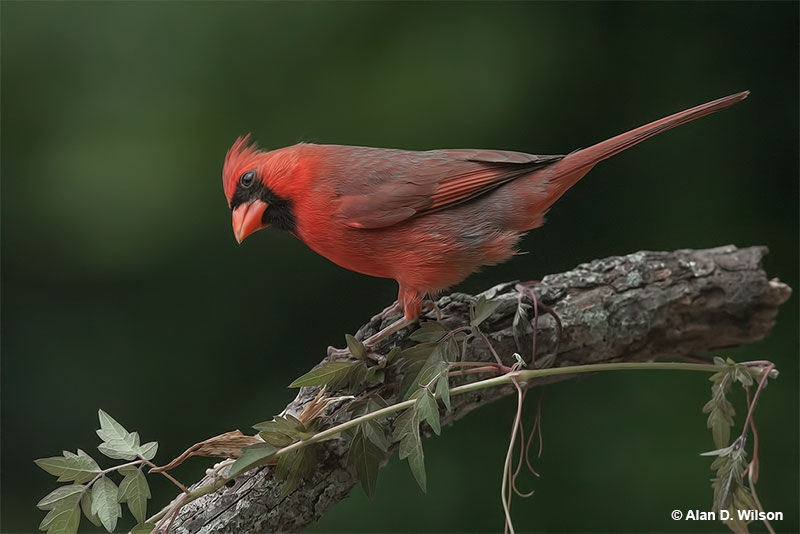
Scientific name: Cardinalis cardinalis
Length: 8.75 inches
Weight: 1.6 ounces
Wingspan: 12 inches
Song: “pichew-pichew-pichew, chew,chew,chew,chew,chew”
Northern Cardinals are medium-sized songbirds with a perky crest and big orange-red beak. Males are bright red with a black throat and face and have dusky red on their back, wings, and tail.
Female Northern Cardinals are grayish-brown and buff with some black on their face and throat. They also have red highlights on their crest, wings, and long, rounded tail.
This species has short, rounded wings and seems to bounce up and down as they move through the air. In flight, Northern Cardinals also make sharp chip notes.
It eats seeds, insects, and some fruit and is a regular visitor to bird feeders. They forage on and near the ground, but males sing from a prominent perch.
This beautiful bird occurs in pairs and nests in bushes and low trees. It is common in the eastern and southwestern USA, southern Ontario, and in Mexico.
Key Identifications:
- Crested bird with a conical orange-red beak and a black face. Males are red, and females are grayish-brown and buff.
- Forages for seeds and insects on and near the ground.
- Makes a cup-shaped nest in bushes and low trees.
- Sings a clear, whistled song of repeated notes. They can sound like “cheer, cheer, chew, chew, chew, chew” or a quick “birdee,birdee,birdee,birdee,birdee“. They also make loud, sharp chip notes.
Northern Cardinals are one of the most beautiful common birds in most states, including Connecticut. It’s no wonder seven different states chose it to be their official bird. Another fun fact about this species is that female Northern Cardinals also sing. They sing while sitting on the nest and may do so to tell their mates to bring food or warn them about predators.
Blue Jay
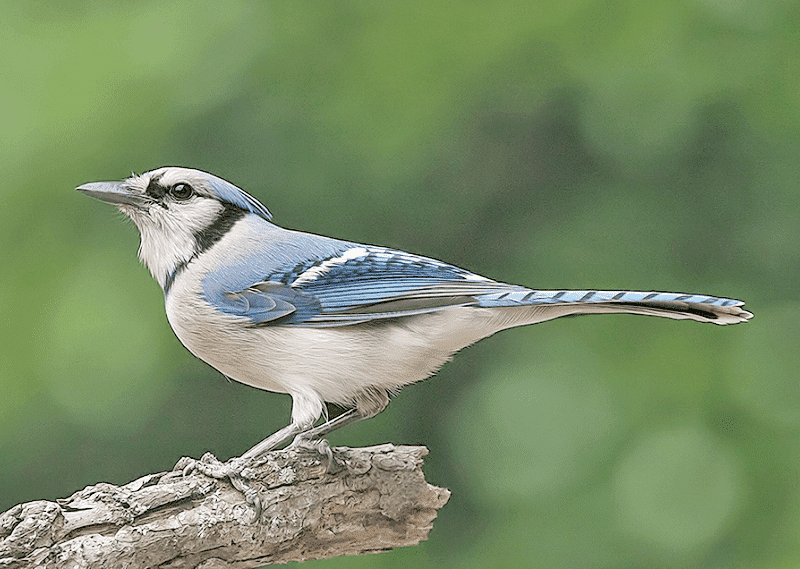
Photograph © Alan Wilson.
Scientific name: Cyanocitta cristata
Length: 11 inches
Weight: 3 ounces
Wingspan: 16 inches
Song: “Nyeah! Nyeah! Nyeah!”
The Blue Jay is a fairly large, crested bird with a straight black bill. Both sexes look alike and are blue above and gray and white below. They also have some small black lines on their faces and a narrow black necklace that goes up to the side of their face and crest.
Blue Jays also have some white markings and black barring on their wings and on their tail. Young birds look like adults but are duller blue.
These social and intelligent birds feed on acorns, nuts, insects, and other small creatures. Like other members of the jay and crow family, they eat the eggs and nestlings of other birds.
The Blue Jay is a common bird of woodlands, forests, and towns east of the Rocky Mountains in the USA and central and southern Canada.
Key Identifications:
- Crested, fairly large bird with bright blue above and gray below.
- Feeds in trees and at feeders. Eats acorns, nuts, insects and many other food items.
- Makes a messy cup nest of sticks in a tree.
- Very vocal. In flight, Blue Jays often call as they swoop through the trees. They make a variety of sounds and mimic some other birds. Common calls include a nasal and complaining “Nyeah! Nyeah! Nyeah!” and various whistled calls.
Blue Jays make their presence known with their loud calls and can visit feeders. Ironically, when communicating with each other at close quarters, this species makes much softer and quieter calls. It’s almost as if they are talking to each other!
Black-capped Chickadee
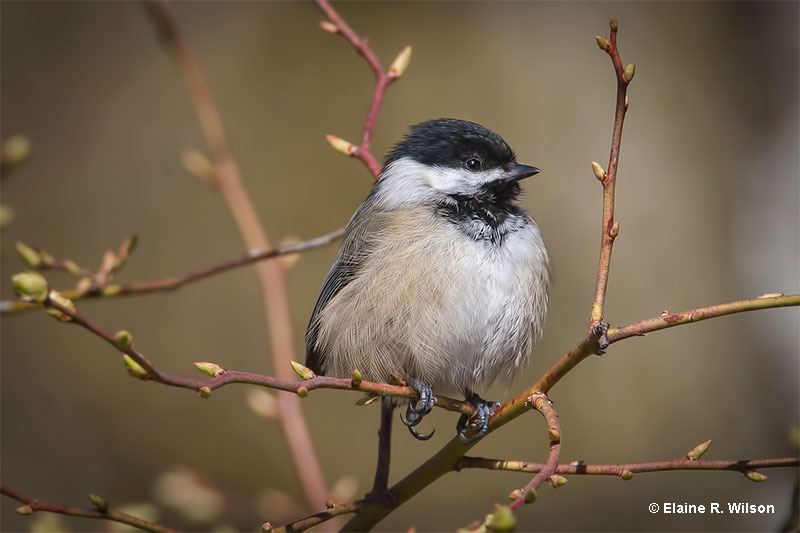
Scientific name: Poecile atricapilla
Length: 5.25 inches
Weight: .39 ounces
Wingspan: 8 inches
Song: “see bee, see bee”
Black-capped Chickadees are small grayish birds with a black cap, black throat, and a stubby black beak. Both sexes look alike and have a white face, white edging to the feathers in their wings, and some buff on their underparts.
These cute little birds feed on caterpillars, insects, spiders, seeds, and fruit. They are regular visitors to feeders but also forage on bark, twigs, and in foliage. When foraging, they often hang upside down from twigs and usually occur in small flocks.
This species makes a small, soft nest out of moss and deer hair. It builds its nest in tree cavities and can also use nest boxes.
Black-capped Chickadees live in a variety of wooded habitats and can also occur in gardens. They are year-round residents in parts of Alaska, Canada, and the northern USA south to Oregon, northern New Mexico, northern Ohio, and the Appalachian Mountains to North Carolina.
Key Identifications:
- Small, cute, grayish birds with a black cap, white face, and a black throat.
- Forages for insects, spiders, seeds, and fruit in wooded habitats. Also visits feeders.
- Nests in tree cavities and nest boxes.
- This little bird is quite vocal and often says its name, “chick-a-deedeedeedeedee”. They also make other chattering calls and sing a whistled song, “see bee, see bee”.
The Black-capped Chickadee is a small, acrobatic bird with a black cap, white face, and a black throat. It is also a state bird of Massachusetts. They usually forage in flocks with other chickadees and other small birds, and often visit feeders. This species hides dozens of seeds and other bits of food for the winter, and recalls where each of these food items are hidden.
Song Sparrow
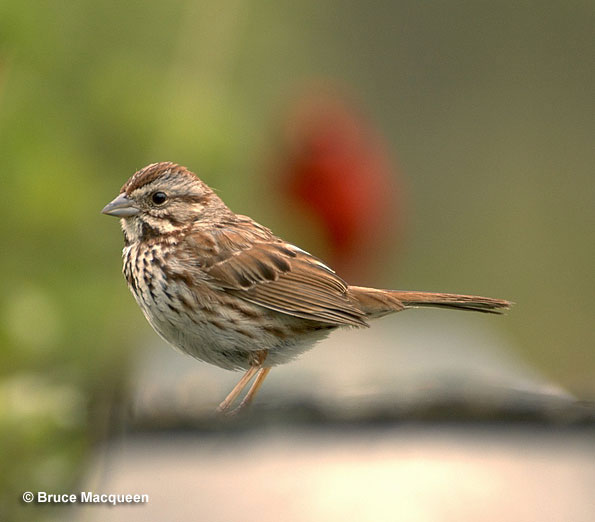
Scientific name: Melospiza melodia
Length: 6.25 inches
Weight: .7 ounces
Wingspan: 8.25 inches
Song: “seet serate sitsziziziziziziziz seet”
The Song Sparrow is a small, gray and brown, streaked songbird with a thick dark mark on each side of its white throat. Males and females look the same and have white underparts with a dark brown mark on their breast, and dark brown streaks on their breast and sides.
Most Song Sparrows also have two narrow wing bars and show a rounded tail when fluttering between bushes.
Song Sparrows feed on insects, seeds, and small fruits. Pairs forage by picking up food items on and near the ground. They are also frequent visitors to bird feeders.
Song Sparrows use grass, stems, hair, and other materials to make a cup nest placed on or near the ground. They nest in dense vegetation, shrubbery, or low trees, often near water.
This species uses a wide variety of brushy habitats in open and wooded situations in southern Alaska, most of Canada, and all of the USA.
Key Identifications:
- Small brown, streaked sparrow with a dark mark on its breast.
- Forages on and near the ground for seeds and insects in brushy habitats.
- Builds a cup nest on or near the ground in a shrub or low tree.
- Makes high-pitched “tink”, chirping calls, and has a cheerful song with a trill, “seet serate sitsziziziziziziziz seet”.
Song Sparrows are reddish-brown songbirds with dark brown streaks and a dark brown breast patch on white underparts. They usually occur in pairs and are often heard and seen in brushy areas and large gardens. There are several subspecies with distinct plumages including a large, dark one that lives on the Aleutian Islands.
American Robin
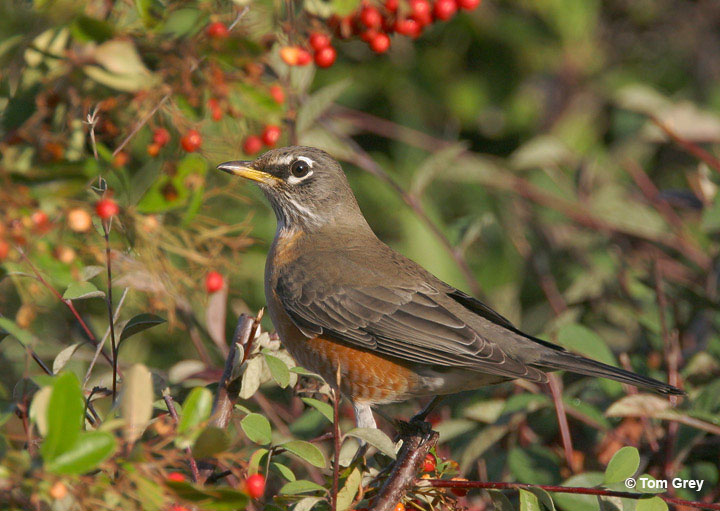
Scientific name: Turdus migratorius
Length: 10 inches
Weight: 2.7 ounces
Wingspan: 17 inches
Song: “cheery, cheery, cheery, cheery, cheer, cheer”
The American Robin is a state bird of Connecticut. It is a familiar and common thrush that is dark gray above and brick red below. It also has an orange-yellow bill, a blackish head with white markings around the eyes and on the throat, and a white belly.
Both sexes of this thrush species are similar, but males are darker above and more reddish on the underparts. Young American Robins have more white marks on their faces and spotting on orange underparts.
In flight, this common thrush in Connecticut also shows white corners in its outer tail feathers.
American Robins forage on the ground for worms, insects, snails, and other small creatures. In winter, these common birds flock together and perch in trees and bushes to eat berries and fruit.
The American Robin makes a cup nest in trees and lives in parks, woodlands, towns, and many other habitats. They reside in Alaska, most of Canada, the USA and in Mexico.
Key Identifications:
- Fair-sized songbird that is dark gray above, and brick red and white below.
- Forages for worms and bugs on lawns and other open grassy areas, also flocks together to feed on fruiting trees in the winter.
- Makes a cup nest in trees.
- The American Robin is quite vocal and makes a loud, sharp, “yenk!” call and quieter “check,check,check” calls. It also has a lovely cheerful song of caroled phrases, “cheery, cheery, cheery, cheery, cheer, cheer”.
With an estimated population of 370 million, the American Robin is considered to be the most numerous landbird in North America.
Tufted Titmouse
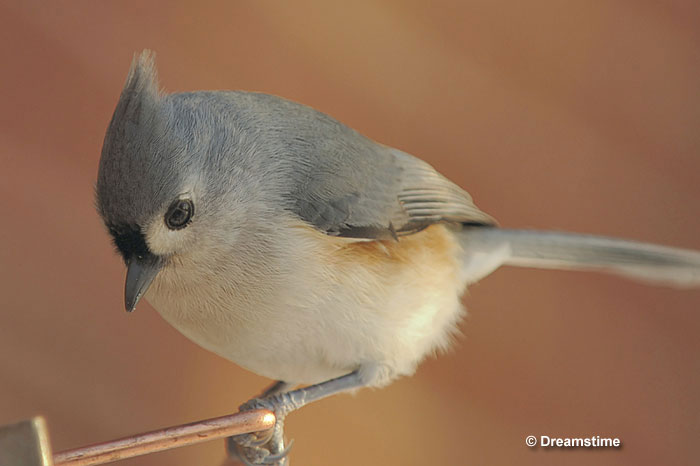
Scientific name: Baeolophus bicolor
Length: 6.5 inches
Weight: .75 ounces
Wingspan: 9.75 inches
Song: “peter peter peter”
The Tufted Titmouse is a small, crested, blue-gray bird with a white face. Males and females look the same and have a small black mark above their stubby black beaks. They also have pale underparts with peach-orange flanks.
These cute little birds occur in small groups that forage for insects and seeds in parks and woodlands. They move through the trees and use their bills to pick food from leaves, bark, and branches. Tufted Titmouse are also regular visitors to bird feeders.
These small birds nest in woodpecker holes and other cavities in dead trees and can also use nest boxes.
We find the Tufted Titmouse in hardwood forests and forested urban areas. They are often heard before they are seen and flock with other small birds. When they see a predator, they are some of the first birds to harass it.
The Tufted Titmouse occurs in the eastern USA and some parts of southeastern Canada.
Key Identifications:
- Small, crested blue-gray bird with pale underparts and a white face.
- Feeds on seeds and insects and visits feeders.
- Nests in tree cavities and nest boxes.
- The Tufted Titmouse is a very vocal bird. It gives constant whistled calls over and over, “peter peter peter“.
The Tufted Titmouse is an easily recognized bird that lives in parks, gardens, and woodlands. It occurs in small flocks, often visits feeders, and needs dead trees or nest boxes to breed. This species lines its nest with mammal hair, including fur from Raccoons, Opossums, and other animals.
Mourning Dove
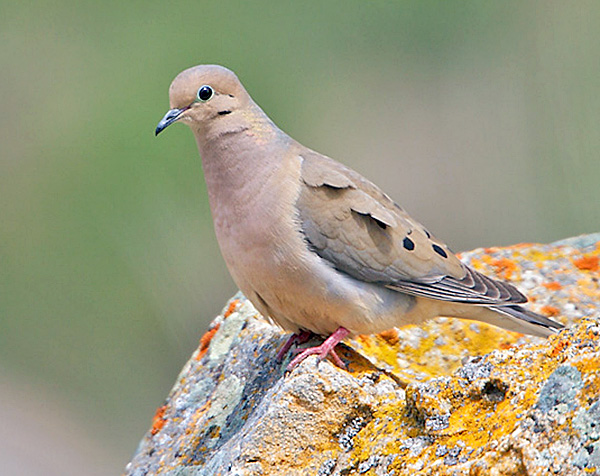
Photograph © Greg Lavaty.
Scientific name: Zenaida macroura
Length: 12 inches
Weight: 4.2 ounces
Wingspan: 18 inches
Song: “hooOOA, hoo, hoo, hoo”
Mourning Doves are medium-sized, grayish-brown doves with long tails. They have small black spots on their wings and a small head with a slender, dark beak.
Males and females also have narrow gray eyerings, a black mark on the face, and pale iridescent gold on the sides of their necks. They look alike except for males having more gray on the head and neck, and more iridescence.
This dove has fairly long wings and swift, direct flight. When flying, it shows black and white in its tail.
The Mourning Dove occurs in woodlands, gardens, on farms, and in urban areas. This common feeder visitor eats seeds and grains. It also forages in open situations, picking food from the ground.
This pleasant dove species can visit a feeder on its own or forage in small flocks. It builds an unkempt stick nest in bushes and trees and is very common throughout the USA, southern Canada, and Mexico.
Key Identifications:
- Plain brown and gray dove with a long, pointed tail.
- Feeds on seeds at feeders and on the ground in open areas.
- Makes a small, messy nest of sticks in trees.
- Sings a sad and owl-like “hooOOA, hoo, hoo, hoo”.
The Mourning Dove is the common garden dove in most of its range. It often visits feeders and its cooing song is commonly mistaken for an owl. This species has a short lifespan, with many adults only living for a couple of years or less.
American Goldfinch
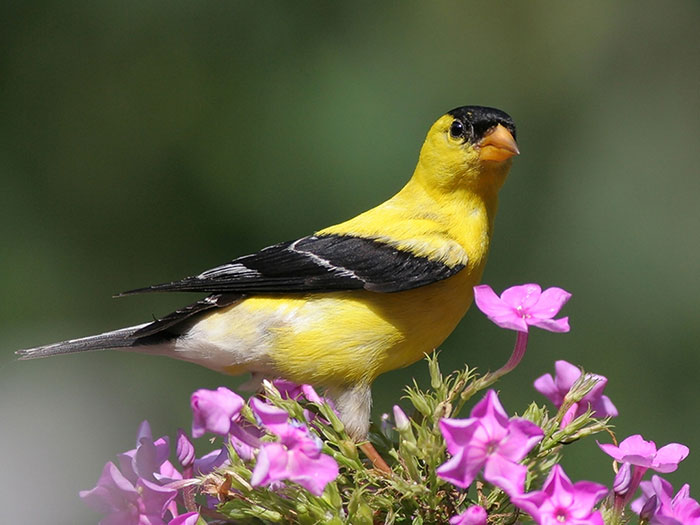
Scientific name: Carduelis tristis
Length: 5 inches
Weight: .46 ounces
Wingspan: 9 inches
Song: “swit sweet, sipsipsipchichisweetsweet”
The American Goldfinch is a small, sparrow-sized finch with a black and white, slightly forked tail, pale rump, and white undertail. In summer, males are bright lemon yellow with a small black cap, pale beak, and have some white markings on long black wings.
Females and wintering birds have two pale wing bars and have plain gray, buff, and yellowish plumage. This species often occurs in small flocks and has bounding flight.
American Goldfinches feed on seeds. They forage by picking them from grass, thistle, other low plants, Alders, and other trees.
The American Goldfinch uses plant matter and other soft materials to build a small, tightly woven cup nest high in a shrub or a low tree.
American Goldfinches are summer residents in southern Canada, California, and the northern half of the USA, and winter in most of the USA and parts of Mexico.
Key Identifications:
- Small, bright yellow finch with a black cap, wings and tail (summer male), female and winter males are plain brown, buff, and yellowish birds with two pale wing bars.
- Feeds on seeds in low plants, trees, and at feeders.
- Makes a tightly woven cup nest high in a shrub or low tree.
- Often gives a “per chickory” call in flight and sings a short, trilled song, “swit sweet, sipsipsipchichisweetsweet”.
American Goldfinches are small, common finches that frequent weedy and brushy fields, second growth, parks, and backyards. Outside of the breeding season, they occur in small flocks and often visit feeders. Brown-headed Cowbirds that hatch in American Goldfinch nests die after a few days because they can’t survive on a diet of seeds.
Downy Woodpecker
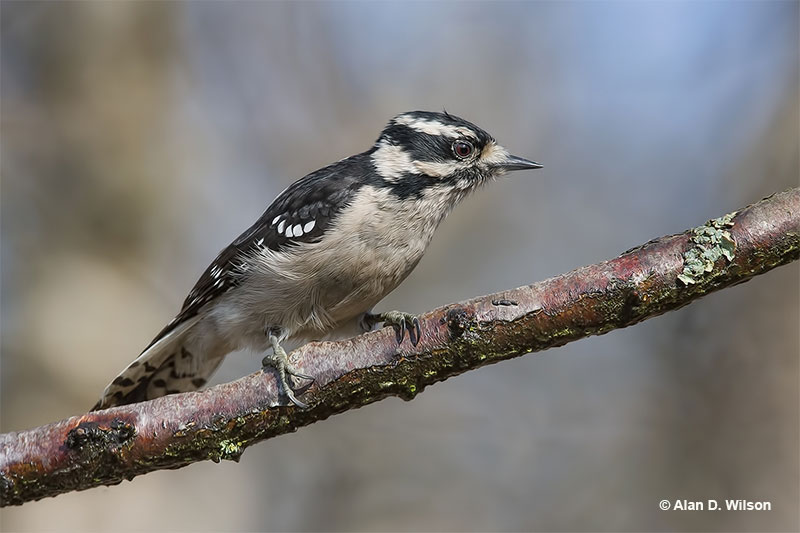
Scientific name: Dryobates pubescens
Length: 6.75 inches
Weight: .95 ounces
Wingspan: 12 inches
Song: “Pik! Ch,ch,ch,ch,ch,ch,ch!”
The Downy Woodpecker is a small black and white woodpecker with a short, black beak. They are patterned black and white above and have white backs and white underparts. Both sexes look alike except that males have a small, bright red patch on the top back part of their head.
Young birds look like adults but have a reddish patch on the top of their heads. Downy Woodpeckers also have a few small black marks in their white outer tail feathers, and a small white tuft at the base of their beak.
This woodpecker eats insects, other small creatures, seeds, and small fruits. It pecks into live and dead wood and often forages on smaller branches and twigs.
They nest in tree cavities and live in gardens and a wide variety of woodlands. We see Downy Woodpeckers in much of Canada and the USA, but not in arid habitats.
Key Identifications:
- Smallest woodpecker in North America. Mostly black and white with a short, black beak.
- Forages on trees, in bushes, and at feeders for insects, seeds, and suet.
- Nests in tree cavities.
- The Downy Woodpecker makes sharp “pik!” calls and also has a trilled call, “Ch,ch,ch,ch,ch,ch,ch!“.
Downy Woodpeckers are the smallest woodpecker species in North America and usually occur in pairs. They can also forage with other small birds and often visit feeders. This species takes advantage of its size to peck into the stems of weeds and other plants too small for larger woodpeckers to perch on.
Red-bellied Woodpecker
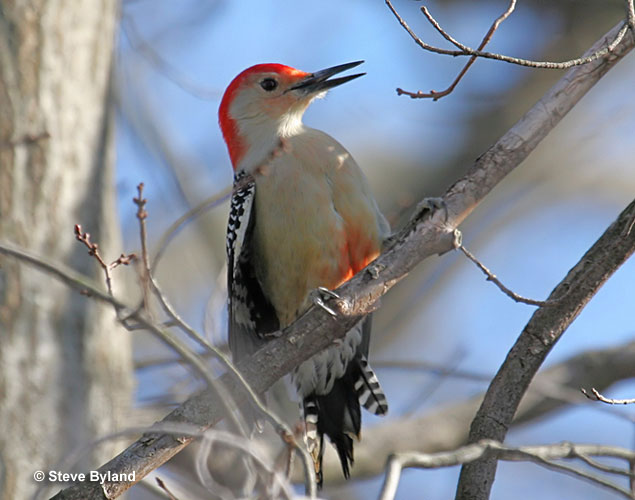
Scientific name: Melanerpes carolinus
Length: 9.25 inches
Weight: 2.2 ounces
Wingspan: 16 inches
Song: “Qwerr!”
Red-bellied Woodpeckers are medium-sized with black and white barring on their back and wings. They have a long beak and pale gray underparts with a small red patch on the belly.
Males have red on the head from the bill to the back of the neck (the nape). Females have an orange-red spot above their bill and red on the back of their heads. Both sexes have a mostly white rump and central tail feathers.
This woodpecker species has long wings and “undulating” flight, moving up and down as they fly. In flight, Red-bellied Woodpeckers show a small white patch in their wings.
The Red-bellied Woodpecker lives in wooded habitats. It eats nuts, seeds, insects, fruit, and can attack nestlings of other species. It also visits bird feeders.
This striking woodpecker occurs in pairs and nests in tree cavities high above the ground. It is common in the eastern USA and parts of southern Ontario.
Key Identifications:
- Grayish woodpecker with black and white barring above, and red on the top of the head and back of the neck.
- Forages for seeds, nuts, insects and other food on trunks and branches.
- Nests in a tree cavity, high overhead.
- Makes a loud exclamation, “Qwerr!“. It also makes other, briefer and quieter “chug” calls.
Red-bellied Woodpeckers are common and adaptable birds. As long as big trees are present, we see them in urban areas as well as wilder places. They also visit feeders and have a very long tongue. When extended, it sticks out 2 inches past the tip of its bill!
American Crow

Scientific name: Corvus brachyrhynchos
Length: 17.5 inches
Weight: 1 pound
Wingspan: 39 inches
Song: “Caw! Caw!”
The American Crow is a big, black bird with a strong, stout bill. In certain lighting, it can have metallic purple and blue iridescence.
Both sexes look the same and have some feathering on their beaks, long, broad wings, and a broad tail.
American Crows have a direct flight with strong, steady wing beats. Crows are very social and intelligent birds that are usually seen in flocks. They forage together on the ground or in trees and eat just about anything they can find.
Some of their more regular foods include carrion, fruit, nuts, seeds, insects, and small animals. Like most jays and crow species, they also eat the eggs and nestlings of other bird species.
This species builds bulky stick nests high in trees and lives in most habitats except for high mountains and arid zones.
The American Crow occurs in southern Alaska and much of Canada and the USA.
Key Identifications:
- Big, all-black bird with long, broad wings and a broad tail.
- Forages for carrion, fruit, seeds, insects, and small animals.
- Builds a bulky stick nest high in a tree.
- American Crows are very vocal birds. They can make several calls, but their most common one is, “Caw! Caw! Caw!”.
The American Crow is a common, large black bird that frequently calls, “Caw! Caw! Caw!”. It usually occurs in flocks and lives in all sorts of places, even urban zones. These birds are very smart and have funerals or wakes! When a crow dies, other crows mark the occasion by gathering together and loudly calling.
White-breasted Nuthatch
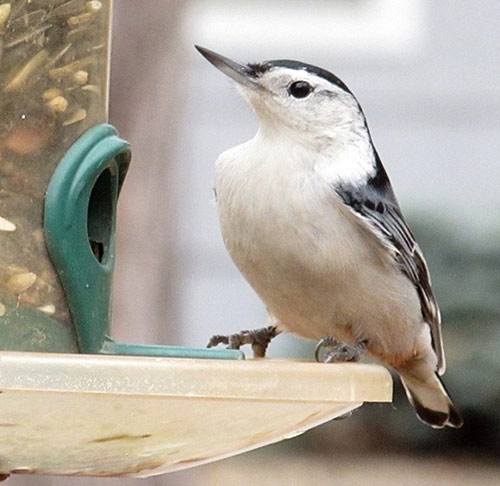
Scientific name: Sitta carolinensis
Length: 5.75 inches
Weight: .74 ounces
Wingspan: 11 inches
Song: “wehn wehn wehn wehn wehn wehn wehn wehn”
The White-breasted Nuthatch is a sparrow-sized bird with a longish, sharp, slightly upturned beak and a short black and white tail. It also has long wings, is mostly blue-gray above, and white and gray below with some chestnut on its belly and undertail.
Both sexes look similar and have a white face, but males have a black cap and nape. Females have gray on their head and nape.
This small bird forages for insects, nuts, and seeds by creeping along branches and going down trunks, head-first.
The White-breasted Nuthatch makes a cup nest out of grass and soft bark inside a tree cavity or nest box.
White-breasted Nuthatches live in various wooded habitats in parts of southern Canada, most of the USA, and mountains in Mexico. They are frequent visitors to gardens near woodlands.
Key Identifications:
- Sparrow-sized, short-tailed songbird that is blue-gray above, mostly white below, and has a longish, slightly upturned beak.
- Creeps on branches and down tree trunks for insects, nuts, and seeds. Also visits feeders.
- Uses grass and soft bark to make a cup nest in a tree cavity or nest box.
- Quite vocal and makes nasal calls “yank yank”, and sings a nasal, laughter-like song, “wehn wehn wehn wehn wehn wehn wehn wehn”.
They creep down trees in many wooded areas and are regular visitors to feeders. This species prefers to forage in flocks with chickadees and titmouse species because they are good at finding food and quick to make alarm calls when they see a predator.
Carolina Wren
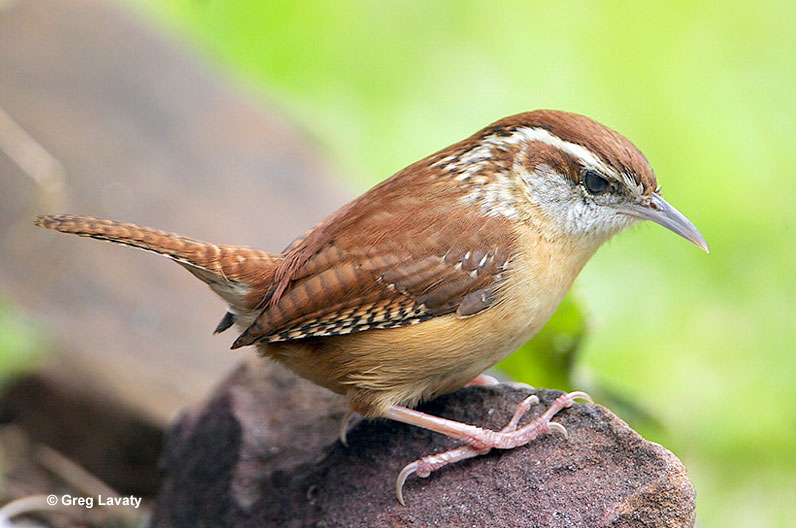
Scientific name: Thryothorus ludovicianus
Length: 5.5 inches
Weight: .74 ounces
Wingspan: 7.5 inches
Song: “teakettle, teakettle, teakettle”
The Carolina Wren is a small, reddish-brown and buff bird with a long, sharp, slightly decurved beak. It has a long, narrow, white eyebrow, a white throat, and some white mottling on its face. Males and females are similar and have black barring on their short wings, long tail, and under the tail.
Juveniles are similar but have paler underparts. This animated and vocal little bird forages for bugs in vine tangles and other dense vegetation. It usually occurs in pairs that can easily hide in the dense vegetation they prefer.
Carolina Wrens build cup nests made of sticks and soft vegetation. There is a side entrance and it can be placed in cavities and crevices of stumps, bushes, trees, potted plants, and other structures.
The Carolina Wren lives in vegetated gardens, second growth, parks and similar habitats in much of the eastern USA, parts of southern Ontario, and parts of eastern Mexico.
Key Identifications:
- Small reddish-brown and buff bird with a long beak and long white eyebrow.
- Feeds on arthropods in dense, tangled vegetation.
- Makes a domed cup nest with a side entrance in crevices, tree cavities, and human-made structures.
- Carolina Wrens fill the garden with loud and melodious songs. One common song sounds like, “teakettle, teakettle, teakettle“. They also make trilled sounds and harsh, nasal calls.
The Carolina Wren is a vocal species of gardens and second growth. Pairs use their long beaks to catch bugs and insects and aren’t shy about nesting near people. Many of these friendly birds have nested in such places as old shoes, potted plants, and abandoned cars.
House Finch
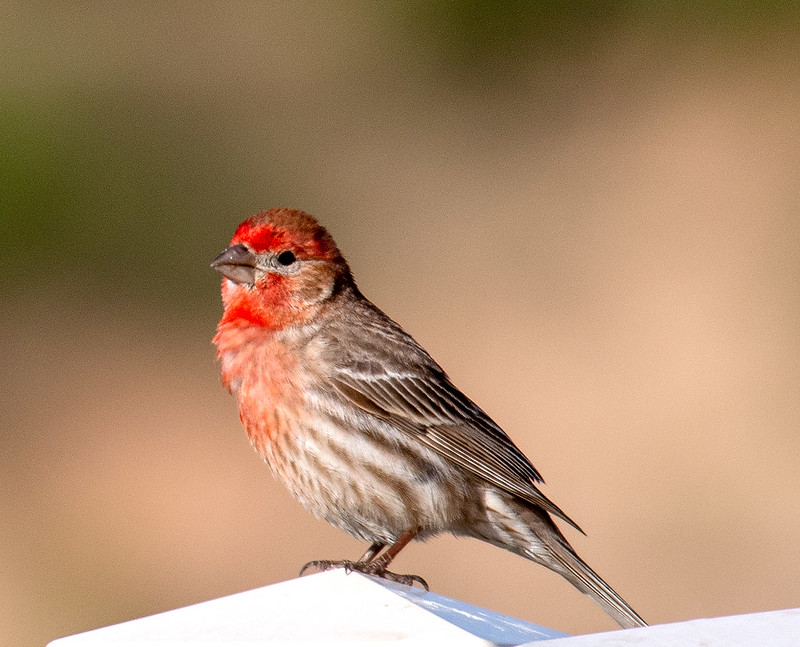
Photograph © John Hansen
Scientific name: Haemorhous mexicanus
Length: 6 inches
Weight: .88 ounces
Wingspan: 10 inches
Song: “chip,chip,chiprididip,ZREEYachip”
House Finches are sparrow-sized birds with dark, rounded beaks and fairly long wings. Males are orange-red or rose-red on their head, throat and breast, and have some red on their rump. They also have brownish streaks on their back, flanks, and white belly.
Like the male, female House Finches have two white wing bars on long, gray-brown wings. However, they lack red and are mostly streaked, dull brown-gray birds.
House Finches feed on seeds, buds, fruit, and flowers. They often visit feeders in Connecticut but also forage on the ground, and in bushes and trees.
We see these pretty birds in deserts and arid zones, and in parks, farmland, urban areas, and other semi-open habitats.
The House Finch makes a soft cup nest built on a tree, building ledge or other spot with some overhanging cover. They often occur in small groups and live in southern Canada, most of the USA, Mexico, and Hawaii.
Key Identifications:
- Reddish or plain gray-brown, streaked, sparrow-like bird.
- Eats seeds, flowers, buds, and fruit. Can visit feeders but also forages on the ground and in bushes and trees.
- Makes a soft cup nest in trees, on building ledges, and other places.
- The House Finch often makes a soft, “fidip” call. Males also sing a warbling song from prominent, high perches. It sounds like, “chip,chip,chiprididip,ZREEYachip”.
They live in arid zones as well as in parks and urban areas. Interestingly, all of the millions of House Finches living east of the Rocky Mountains are descendants of birds released on Long Island in 1939.
House Sparrow
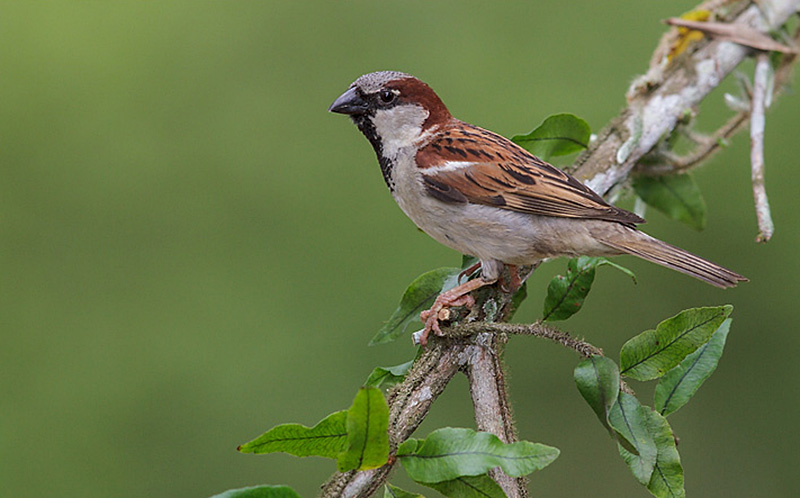
Scientific name: Passer domesticus
Length: 6.25 inches
Weight: .98 ounces
Wingspan: 9.5 inches
Song: “see,chirrup,see,chirrup,see,chirrup”
House Sparrows are small, plump gray and brown birds with conical, finch-like beaks. Males have a gray and rufous head with pale cheeks and black near their eyes and on their throat.
The rest of their underparts are gray and they have brown, streaked backs with rufous highlights. They also have a white mark in the shoulder of each wing and a grayish rump and tail.
Females are plainer brown and buff, have paler beaks, and buff eyebrows.
House Sparrows feed on seeds, grain, and insects. They are regular visitors to bird feeders and often dominate other smaller species. They also forage on the ground in farmlands, parks, urban areas, and other open situations.
The House Sparrow nests in cavities. When searching for suitable nesting sites, they can kill and remove the eggs and young of smaller species like Eastern Bluebirds.
House Sparrows usually live near people and occur in most of North America, including Connecticut.
Key Identifications:
- Brown and gray sparrow with a bold pattern on its head.
- Feeds on seeds, grain, and insects at feeders and on the ground in urban areas and farmlands.
- Nests in tree cavities, including nest boxes.
- This species is vocal and often makes short chirping calls. Its song is a friendly series of chirping sounds, “see,chirrup,see,chirrup,see,chirrup”.
In many places, the House Sparrow is the common urban sparrow. It occurs in pairs and small groups that forage on sidewalks, in parking lots, farm fields, and other familiar places. This species is one of the very few birds that has evolved to live with people and digest the same grains that we eat.
Canada Goose
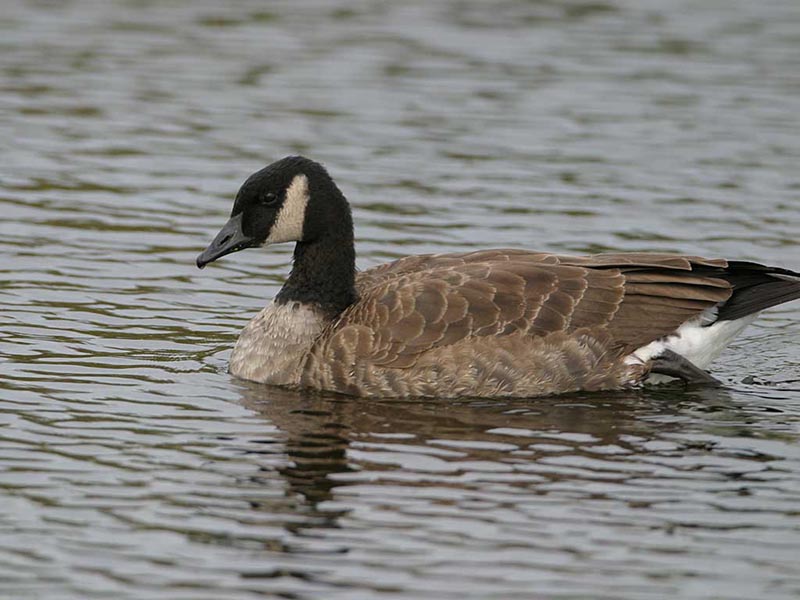
Scientific name: Branta canadensis
Length: 35 – 45.2 inches
Weight: 5.29 – 19.8 pounds
Wingspan: 50 – 67 inches
Song: “uurrRUNK! uurrRUNK!”
The Canada Goose is a large, grayish-brown bird with a long black neck, and black head with a white throat and cheeks. Males and females look alike and have pale barring, a white belly and undertail, and a short black and white tail.
They have strong, direct flight and make deep flaps with long, broad wings.
Canada Geese feed on grass, sedges, and other vegetation, grain, and berries. They forage by walking along and grazing, or picking food from the ground and bushes. They feed by dipping their heads below the surface of shallow water.
This large goose uses grass and other plants to make a large, shallow cup nest on a small mound or other elevated spot next to water.
The Canada Goose prefers open grassy areas and farm fields near water where it can feed and see predators before they get too close. They live in Alaska, most of Canada, and most of the USA, being one of the most common birds of Connecticut.
Key Identifications:
- Big, gray-brown goose with a long black neck, and black and white head.
- Grazes vegetation and forages for berries in wide open, grassy habitats near water like golf courses, parks, and airports.
- Makes a shallow, open cup nest on an elevated spot next to water.
- Vocal and often makes honking calls, “uurrRUNK! uurrRUNK!”.
Canada Geese are a large, common goose species with long black necks, and a black and white head. These big birds are a common sight on golf courses and other places that combine open lawns and water. When the Canada Goose and other birds migrate in “V” formation, they expend less energy than flying on their own.
Gray Catbird
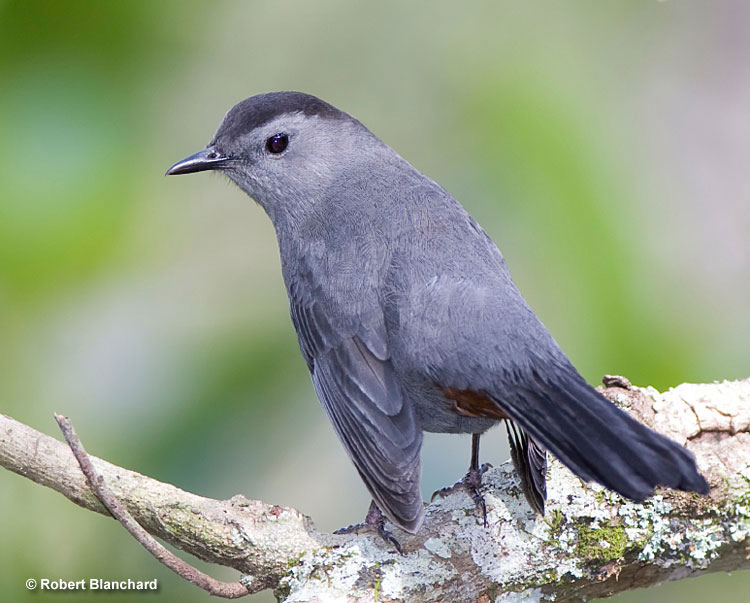
Scientific name: Dumatella carolinensis
Length: 8.5 inches
Weight: 1.3 ounces
Wingspan: 11 inches
Song: “rheah!”
The Gray Catbird is a slender, gray songbird with a black cap, and chestnut under its tail. Both sexes look alike and have beady, black eyes on a gray face, a longish tail, and a smallish, black beak.
This reclusive bird feeds on insects and berries in thickets and second growth. It forages by moving through dense vegetation and picking food items from leaves and twigs.
Gray Catbirds make bulky cup nests constructed with grass, strips of vegetation, and hair. They build their nests in shrubs, bushes, and small trees.
The Gray Catbird is often heard before it is seen, and loves to skulk in low thick vegetation.
This migrant species spends summers in southern Canada, and in much of the eastern and northern USA. In fall, it migrates to coastal areas in the eastern and southern USA, and Florida south to northern South America.
Key Identifications:
- Small to medium-sized, slender gray bird with a black cap and chestnut under the tail.
- Feeds on insects and berries in low, dense vegetation.
- Builds a bulky cup nest in small trees and bushes.
- The Gray Catbird is quite vocal and often makes a cat-like mewing call, “rheah!”. It also has a melodious, complex song made of jumbled, chattering sounds and phrases.
Pairs forage for bugs and berries in dense second growth. Although they don’t mimic as many bird species as their mockingbird relatives, Gray Catbird songs include the sounds of some birds, frogs, and other noises.
European Starling
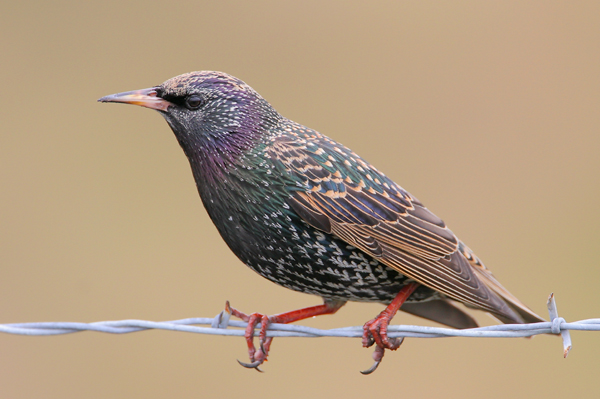
Photograph © Greg Lavaty.
Scientific name: Sturnus vulgaris
Length: 8.5 inches
Weight: 2.9 ounces
Wingspan: 16 inches
Song: “tiktiktitZHREEree..tiktiktik..ZHREE”
European Starlings are plump, short-tailed birds with long sharp beaks and longish, pointed wings. In summer, they have yellow beaks, glossy black plumage with purple and green highlights, and some small white spots.
Males and females are similar, but males have less spotting and glossier plumage. In winter, they have black beaks, white spots, and more reddish colors in their wings.
Young starlings are shaped like adults but are grayish birds with a dark beak and a pale throat.
This species feeds on a variety of insects, fruit, and seeds. They can dominate bird feeders and are common species in urban areas, parks, farmlands, and other open habitats.
This European Starling builds a soft cup nest in a tree cavity, nest box, or suitable cavity in other structures.
European Starlings flock with each other and blackbird species, especially during the winter. They live across a large part of Canada and the USA.
Key Identifications:
- Rotund, short-tailed bird with a long, sharp beak, and pointed wings. Glossy black with some spotting in the summer and blackish with heavy white spotting and streaking in the winter.
- Feeds on seeds, fruit, and insects. Visits feeders and forages on the ground in flocks.
- Builds a soft cup nest in nest boxes and other cavities.
- The European Starling makes a wide variety of mechanical and whistled sounds. They also mimic other birds and sounds in their environment. They sing long, jumbled mechanical-sounding songs, “tiktiktitZHREEree..tiktiktik..ZHREE”.
European Starlings live in towns, cities, parks, on farms, and in other open habitats. This species forms large flocks called murmurations that move in coordinated patterns.
Red-winged Blackbird
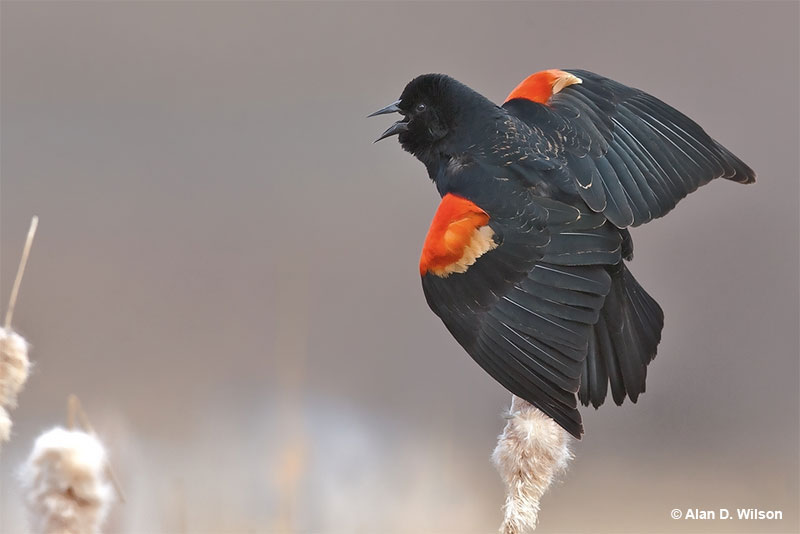
Scientific name: Agelaius phoeniceus
Length: 8.75 inches
Weight: 1.8 ounces
Wingspan: 13 inches
Song: “kan-keree!”
The Red-winged Blackbird is a medium-sized blackbird species with a sharp, black bill. Males also have a scarlet patch with a pale yellow border on the shoulder of each wing.
Female Red-winged Blackbirds are dark, heavily streaked, brownish-gray birds with an orange-buff eyebrow and throat. She can also have a little bit of dingy red on her shoulder.
Red-winged Blackbirds often flock together and can form very large groups in the winter. They feed on seeds, grain, and insects found on lawns, in marshes, farm fields, and other open habitats.
This species builds a cup nest made of leaves and dead stems in a bush or other low vegetation in a marsh, park, or brushy field.
Red-winged Blackbirds are very common birds that live in all sorts of open habitats. We see them in parks, farming areas, and marshes in much of Canada, the USA, Mexico, and parts of the Central America.
Key Identifications:
- Males are medium-sized blackbirds with a bright red patch on their wings. Females are heavily streaked, have a sharp black beak, and buff on the head.
- Feeds on seeds, grain, and insects on the ground in many open habitats.
- Builds a cup nest in a bush or other low vegetation.
- Red-winged Blackbirds often call. Males sing a loud, “kan-keree!” and both sexes also make “check!” calls and a high-pitched whistle-like sound.
The Red-winged Blackbird is a common, social species easily seen in marshes and open habitats. In the winter, it can form huge flocks that feed in farm fields. This species can make a daily commute of 50 miles to and from roosting and feeding sites.
White-throated Sparrow
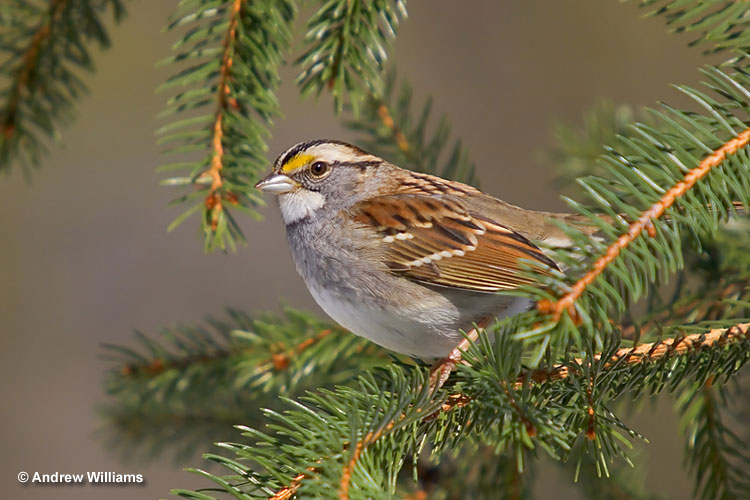
Scientific name: Zonotrichia albicollis
Length: 6.75 inches
Weight: .91 ounces
Wingspan: 9 inches
Song: “Ohhh Canada Canada Canada”
The White-throated Sparrow is a chunky, gray and brown sparrow with a white throat, and black and white stripes on its head. It has dark streaks on its back, a gray rump, and a bit of yellow in front of its eyes.
Males and females look the same and have reddish-brown wings with two white wing bars. Young White-throated Sparrows and some adults are duller brown with tan stripes on their heads and a dingy white throat.
White-throated Sparrows forage for seeds and insects on the ground, and also eat fruits in short trees and bushes. They reveal hidden food items by using their feet to scratch and kick away leaves.
This sparrow breeds in northern forests and builds a cup nest with grass and twigs. They construct the nest at the edge of forest, on or close to the ground, in dense vegetation.
These sparrows usually occur in flocks and winter in the eastern and southwestern USA and parts of California.
Key Identifications:
- Large sparrow with a white throat and bold black and white or tan stripes on its head.
- Scratches leaves on the ground to find seeds and insects. They also eat berries.
- Makes a cup nest of grass, bark, and twigs, on the ground, under dense vegetation.
- Flocks of White-throated Sparrows often make sharp “tink” calls. They also sing a clear, whistled song, “Ohhh Canada Canada Canada” or, “Ohhh, Cana, Cana, Cana”.
White-throated Sparrows breed in northern forests and flock together during the winter in various woodland habitats. The yellow pigment in the patches in front of their eyes comes from eating colorful berries during fall and winter.
Common Grackle
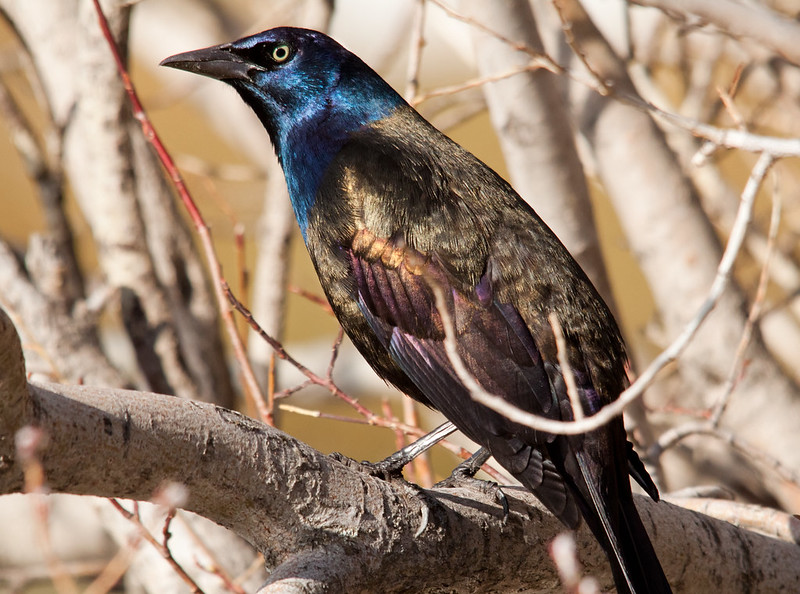
© Shawn McCready
Scientific name: Quiscalus quiscula
Length: 12.5 inches
Weight: 4 ounces
Wingspan: 17 inches
Song: “Sherink!”
The Common Grackle is a jay-sized, glossy black bird with pale eyes and a long, wedge-shaped tail. Depending on lighting, this bird shows metallic purple, blue, green, and bronze highlights.
Males and females look very similar, but females have shorter tails and less iridescence. Both sexes also have stout, black beaks and strong, black legs and feet.
In flight, Common Grackles move up and down as they move through the air. They usually flock together and often forage in farm fields, on lawns, and in other open habitats.
Common Grackles are omnivores who feed on a variety of items, including insects, seeds, grain, small animals, garbage, and the eggs and nestlings of other birds.
Common Grackles build bulky stick nests, usually in conifers in woodlands, parks, near water, and urban areas.
This species can form big flocks in the winter and lives in a variety of semi-open and open habitats in eastern Canada and the eastern USA.
Key Identifications:
- Fairly large, black bird with glossy purple, greenish, bronze, or dark blue highlights. It also has pale eyes and a long, wedge-shaped tail.
- Forages for insects, seeds, and other food on the ground in a variety of open habitats.
- Constructs a bulky cup nest in a conifer.
- Common Grackles are vocal birds. They frequently give raspy, metallic calls, “Sherink!”, and “kek” calls.
The Common Grackle is a common, glossy black bird with pale eyes. It usually occurs in flocks in open and park-like habitats. This species occasionally nests in odd places, including occupied nests of Great Blue Herons and Ospreys!
Mallard
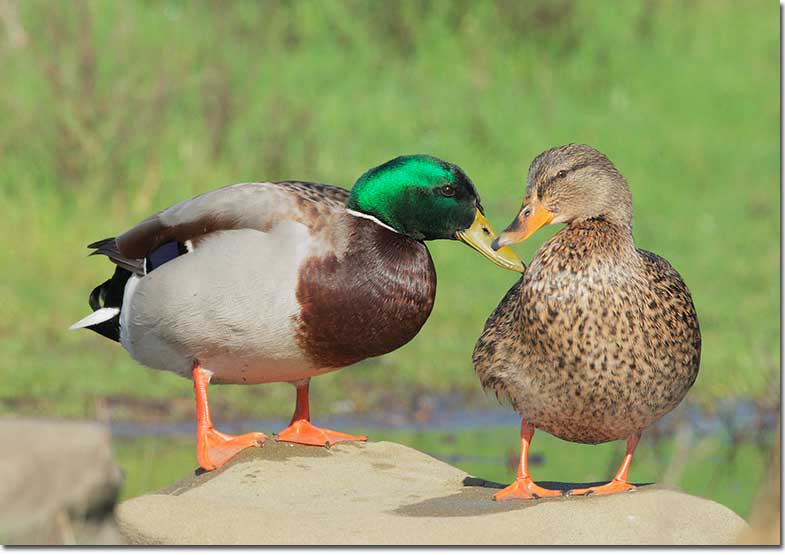
Mallard pair (Male and female)
Scientific name: Anas platyrhynchos
Length: 23 inches
Weight: 2.4 pounds
Wingspan: 35 inches
Song: “quack, quack”
The Mallard is a fairly large, familiar duck. The male has a metallic green head, yellow bill, narrow white ring around the neck, and chestnut breast. The rest of the bird is pale gray with pale brown, and black on its back and around its tail.
Female Mallards are mottled brown and buff with a dark crown and line through the eyes and have a dark gray and orange beak.
In flight, both sexes show a green-blue wing patch bordered with white.
Mallards eat a variety of items, including insect larvae, snails, other small aquatic creatures, acorns, seeds, and grain. They forage by filtering and picking up food items in and near shallow water, and in farm fields.
This Connecticut duck species makes a shallow nest with sticks and lined with down feathers. It builds its nest on the ground, hidden in grass or under a bush.
The Mallard lives in ponds, marshes, and many wetland habitats in Canada, USA, and Eurasia.
Key Identifications:
- Feeds on insect larvae, grain, seeds, and other items picked up with its bill in and near shallow water.
- Makes a shallow stick nest hidden in grass or under a bush.
- The female Mallard makes the classic “quack, quack” duck sound. Males make similar but softer sounds and a whistling call.
This duck species often lives near people and occurs on lakes, ponds, and other wetlands. No matter how different they look, most small domestic duck species are descended from wild Mallards.
Dark-eyed Junco
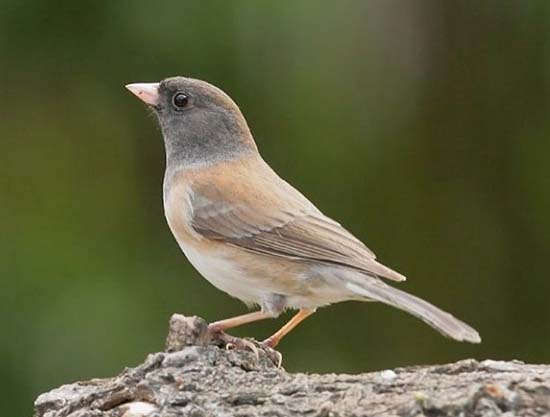
Scientific name: Junco hyemalis
Length: 6.25 inches
Weight: .67 ounces
Wingspan: 9.25 inches
Song: “sipsipsipsipsipsipsip”
Dark-eyed Juncos are sparrow-like birds with pale conical bills and dark eyes. This small bird has variable plumage, with most being slate gray or gray and brown with white on their bellies, and white under their tails.
Other plumages include birds with dark masks and faint white wing bars, juncos with pale gray hoods and pinkish sides, and birds with blackish hoods and chestnut sides.
In flight, all Dark-eyed Juncos show extensive white in their longish tails.
This species feeds on seeds, insects, and some fruit and grain. Juncos forage on the ground in wooded areas, parks, and other habitats. They also feed on fallen seeds beneath feeders.
They build cup nests on the ground under fallen logs, in roots, and other hidden spots. After breeding, juncos form flocks that forage together in similar wooded and semi-open habitats.
Dark-eyed Juncos are common birds in Canada, the USA, and parts of Mexico.
Key Identifications:
- Sparrow-like gray and brown bird with dark eyes, a pale beak, and white in the tail.
- Forages for seeds and insects on the ground, can feed on seeds at and beneath feeders.
- Builds a cup-shaped nest on the ground in tree roots, under logs, and other hidden places.
- This species often makes a sharp, high-pitched chip note, “pik!”. On breeding grounds, males sing a short, plain trill, “sipsipsipsipsipsipsip”.
Common wintering birds in many areas, they forage for seeds on the ground in wooded and park-like habitats. In many places, this common species is also known as Snowbirds on account of only occurring in the winter months and having white on the belly and tail.
Herring Gull
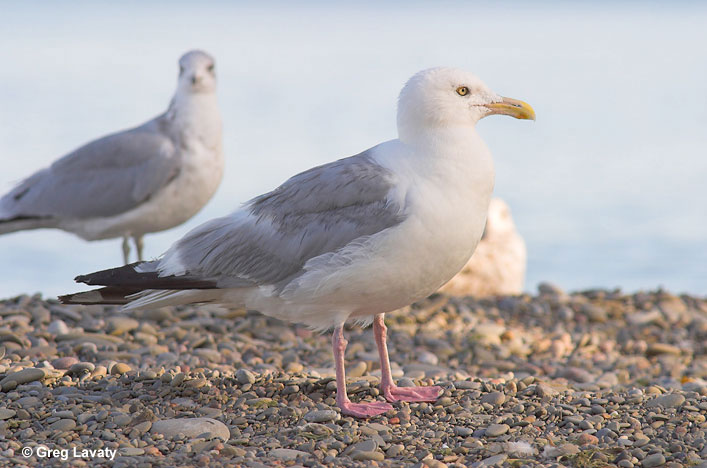
Scientific name: Larus argentatus
Length: 25 inches
Weight: 2.5 pounds
Wingspan: 58 inches
Song: “klew klecka klecka kleckla klecka klew klew klew klew”
The Herring Gull is a large, pale gray and white gull with pink feet, a pale eye, and a strong, yellowish beak with a small hooked tip.
Male and female adults have black wingtips with a few white spots, and, in winter, have grayish-brown streaking on their heads. Depending on their age, young birds are brownish or gray and brown with a black tail, have a pale patch on each wing, and a dark bill or a pale beak with a dark tip.
This species is omnivorous and scavenges beaches, lakes, and rivers for fish, small animals, and other scraps of food. It can be seen alone but usually occurs in flocks.
The Herring Gull uses bits of grass and other slender objects to make a shallow cup nest on the ground. It nests in open places with sparse vegetation.
Herring Gulls occur on lakes, rivers, and coastal habitats in much of North America, including Connecticut.
Key Identifications:
- Large pale gray and white gull with pink legs, a strong yellowish beak, and pale eyes.
- Feeds on carrion, small animals, fish, and other food items.
- Makes a shallow cup nest of sticks and other items on the ground in open areas.
- Herring Gulls have loud and raucous calls, “klew klecka klecka kleckla klecka klew klew klew klew”.
The Herring Gull is a large pale gray and white gull with pink feet and a strong yellowish beak. Individuals and loose flocks frequent lakes, large rivers, garbage dumps, and coastal habitats. Although this species is named after one of its food sources, its diet also includes many other items, even garbage.
Northern Flicker
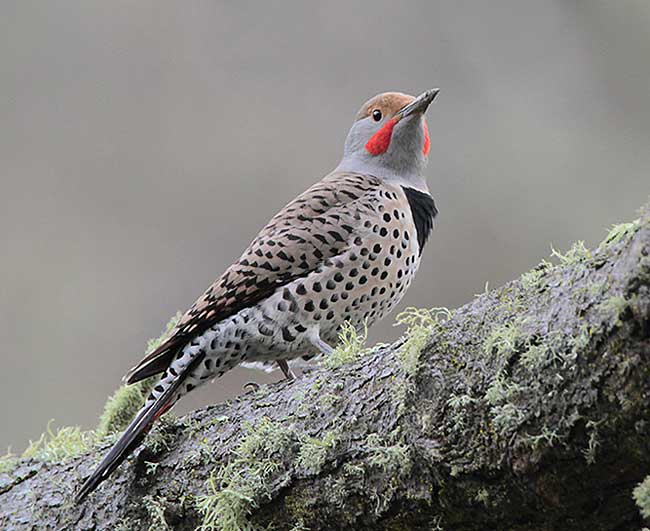
Scientific name: Colaptes auratus
Length: 12.5 inches
Weight: 4.6 ounces
Wingspan: 20 inches
Song: “kick,kick,kik,kik,kik.kik.kik.kik.kik.kik.kik.kik!”
Northern Flickers are fairly large, tan and gray woodpeckers with barring on their backs. They have a black mark on their breast, black spotting below, and a dark, stout beak.
Males in the east have a tawny throat and face with a black mustache and small red spot on the back of their heads. Males in the west have mostly gray heads with a red mustache.
Female Northern Flickers look like males but lack the mustache mark.
In bounding flight, they have white rumps and flash color on their underwings. This is bright yellow in eastern birds and reddish in flickers west of the Rocky Mountains.
This woodpecker eats many ants and other insects that it catches on the ground. It forages by flying to the ground, locating anthills, and lapping them up with its long tongue.
Northern Flickers nest in tree cavities and live in wooded and open habitats in Canada, the USA, and Mexico.
Key Identifications:
- Tan and gray woodpecker with black barring above, black marks below, and a bright, white rump.
- Forages for ants and other insects on the ground.
- Nests in tree cavities.
- A vocal woodpecker, the Northern Flicker often gives loud, “flicka,flicka,flicka” calls, and another loud, single note that sounds like, “Keer!” They also have a long, laughing vocalization of repeated notes, “kick,kick,kik,kik,kik.kik.kik.kik.kik.kik.kik.kik!”.
Northern Flickers are fairly big, tan woodpeckers with gray highlights, a white rump, and black markings. They mostly forage for ants on the ground in open and wooded areas. The red-shafted Northern Flickers in the west used to be considered a separate species from the yellow-shafted flickers of the east. At present, they are considered to be one species because they frequently hybridize with each other.
Ring-billed Gull
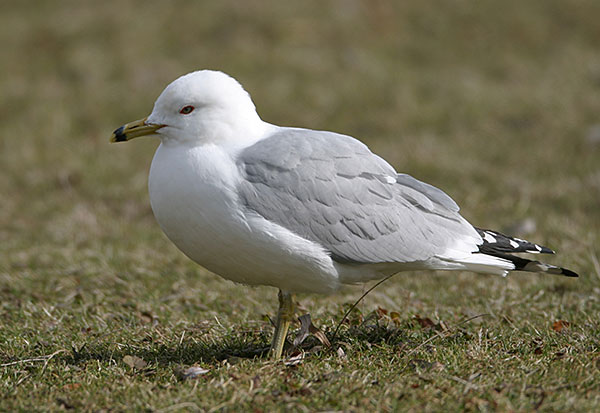
Scientific name: Larus delawarensis
Length: 17.5 inches
Weight: 1.1 pound
Wingspan: 48 inches
Song: “KLEE..KLEEE..kleeya,kleeya,kleeya”
The Ring-billed Gull is a medium-sized pale gray and white gull with a black ring around its yellowish beak. Males and females look the same and have yellowish legs and feet, pale eyes, and black wing tips with a few white spots.
These gulls have a direct, fairly quick flight with leisurely wing beats. Young birds have pink and black bills, a white tail with a black tip, and mottled black and gray wings.
Ring-billed Gulls are scavengers and opportunists that feed on carrion, fish, worms, small animals, grain, and other food items. They usually occur in flocks that roam lakes, rivers, urban areas, and other habitats in search of feeding opportunities.
The Ring-billed Gull breeds in colonies, often on islands, and makes a shallow stick nest on the ground.
This gull species occurs not only in Connecticut but also in many parts of Canada and the USA south to Central America.
Key Identifications:
- Medium-sized pale gray and white gull with a black ring on its bill and yellow legs and feet. Juveniles have pink and black beaks.
- Forages for fish, carrion, and many other food items in wetlands and open habitats.
- Nests on the ground, in colonies.
- Ring-billed Gulls often call. In flight, they often make a high-pitched “kleea” sound. On the ground, displaying birds make a loud, laughing, “KLEE..KLEEE..kleeya,kleeya,kleeya”.
They are well adapted to living with people and occur around lakes, rivers, and other wetlands, parking lots, garbage dumps, and other places. This gull species is a bold bird that can snatch bits of food from unguarded picnic tables.
Great Blue Heron
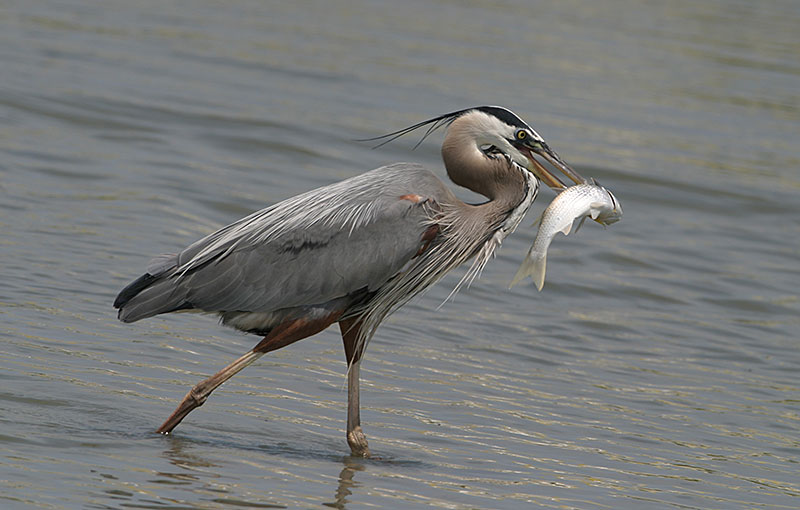
Scientific name: Ardea herodias
Length: 46 inches
Weight: 5.3 pounds
Wingspan: 72 inches
Song: “Grunk! Grunk!”
The Great Blue Heron is a large, gray, pale brown heron with long neck and legs. It has a strong, yellowish beak, black and white head with a wispy black crest, and rufous thighs.
Both sexes are alike and have pale bellies and black flanks. Juveniles have streaked underparts.
In flight, they make slow, deep flaps with long, broad gray and black wings.
In Southern Florida and the Caribbean, Great Blue Herons are all white and sometimes considered a separate species, the “Great White Heron”.
These powerful herons feed on fish and small animals such as rats, snakes, and birds.
Great Blue Herons build messy, stick nests and breed in colonies, often in swamps.
We find these impressive birds in and near a wide variety of wetlands in large parts of Canada, the USA, and the Caribbean.
Key Identifications:
- Huge gray and pale brown wading bird with a thick, yellowish beak and a wispy crest. In southern Florida, it is all white but still has a crest and a strong yellowish beak.
- Stalks and preys on fish and small animals.
- Builds messy stick nests and breeds in colonies.
- Great Blue Herons aren’t all that vocal. When taking flight they make a croaking sound, “Grunk! Grunk!“.
The Great Blue Heron occurs on rivers, lakes, and many other wetlands. It stands still for long periods of time while waiting for prey to come within range of its sharp beak, but is also often seen in flight.
Chipping Sparrow
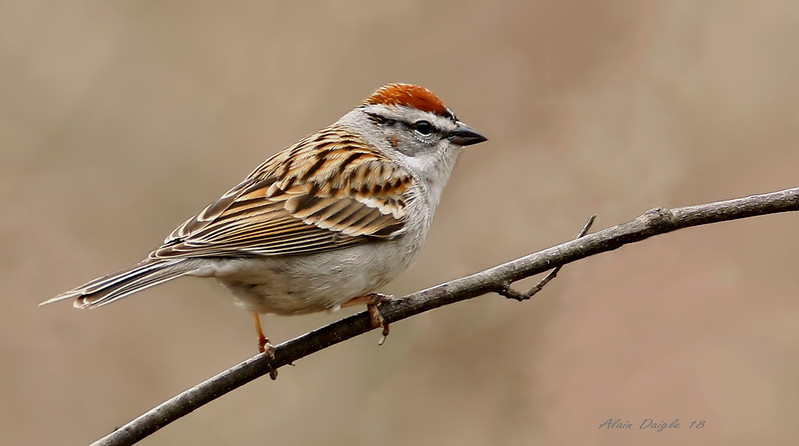
© Alain Daigle
Scientific name: Spizella passerina
Length: 5.5 inches
Weight: .42 ounces
Wingspan: 8.5 inches
Song: “titititititititititititti”
The Chipping Sparrow is a small, brown and gray sparrow with a longish, slightly forked tail and a conical bill. In summer, it has a rufous cap, white eyebrow, and dark line through each eye.
Males and females look the same and have small white crescents above and below the eyes, a pale brown back with dark streaks, gray rump and underparts, and pale brown wings with two pale wing bars.
In fall and winter, Chipping Sparrows are duller, have brown and buff heads, a gray rump, and a dark line through their eyes.
This species forages on the ground for insects and small seeds in open, grassy areas near conifers.
Chipping Sparrows use grass, hair, and other materials to make a cup nest low in a bush or small tree.
These sparrows live in parks, open woodlands, and on golf courses in much of Canada, most of the USA, and parts of Mexico.
Key Identifications:
- Small, slender sparrow with a rufous cap and white eyebrow in summer and a brown and buff head, gray rump, and dark line through their eyes in the winter.
- Forages for insects and seeds on the ground in grassy habitats with pines.
- Uses grass and animal hair to make an open cup nest low in a bush or small tree.
- Makes short chip notes and has a mechanical-sounding, trilled song, “titititititititititititti”.
The Chipping Sparrow is a small and slender sparrow with a rufous cap and pale eyebrow. They are common birds of golf courses and other similar, semi-open habitats and flock together during the winter. Chipping Sparrows eat more than 70 times their own weight in seeds, every winter!
Northern Mockingbird
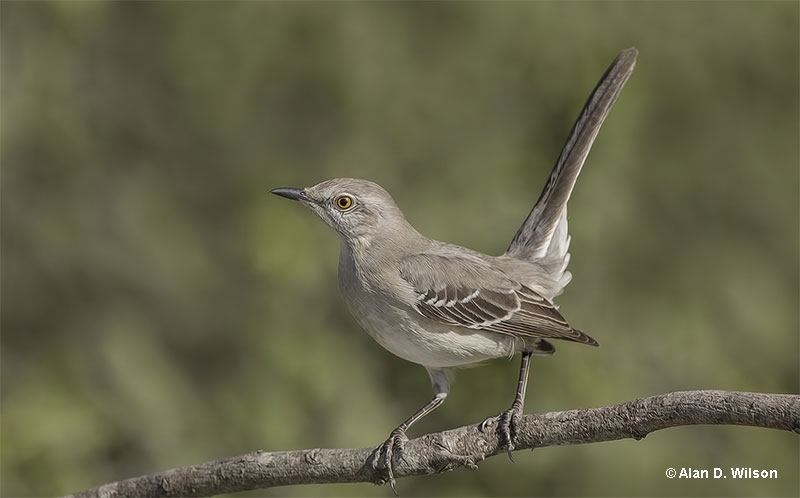
Scientific name: Mimus polyglottos
Length: 10 inches
Weight: 1.7 ounces
Wingspan: 14 inches
Song: “kerdee, kerdee, kerdee…jirdle,jirdle,jidrle…”
The Northern Mockingbird is a pale gray and white bird with a long tail. Around the same size as an American Robin, it has a dark line through a pale eye, a short, slender beak, and two white wing bars.
Both sexes look alike, are gray and white, and buff below. In flight, this bird shows a blackish tail with white outer feathers and a big white wing patch.
Northern Mockingbirds feed on insects and berries. They forage in open grassy spots on the ground. These animated birds run and pick bugs from the ground and fly up to catch insects in flight. In winter, they also perch in bushes to feast on berries.
The Northern Mockingbird lives in towns, parks, and other semi-open habitats, and builds cup nests in bushes and low trees. Northern Mockingbirds are common garden birds in much of the eastern and southern USA, southern Ontario, and Mexico.
Key Identifications:
- Vocal, gray and white bird with a small bill, white wing patches, and a long, black and white tail.
- Feeds on the ground in open areas and in bushes. Mostly eats insects and berries.
- Makes a cup nest in a bush or low tree.
- Very vocal. Sings many phrases and mimics many other birds. Some of the more regular phrases sound like, “kerdee, kerdee, kerdee…jirdle,jirdle,jidrle…“. These are interspered with the calls of Blue Jays, woodpeckers, Tufted Titmouse, and various other bird species.
Northern Mockingbirds can mimic the calls of 35 bird species as well as mechanical sounds. More than a century ago, these avian virtuosos were highly prized as a cagebird and were traded for large sums of money.
Hairy Woodpecker
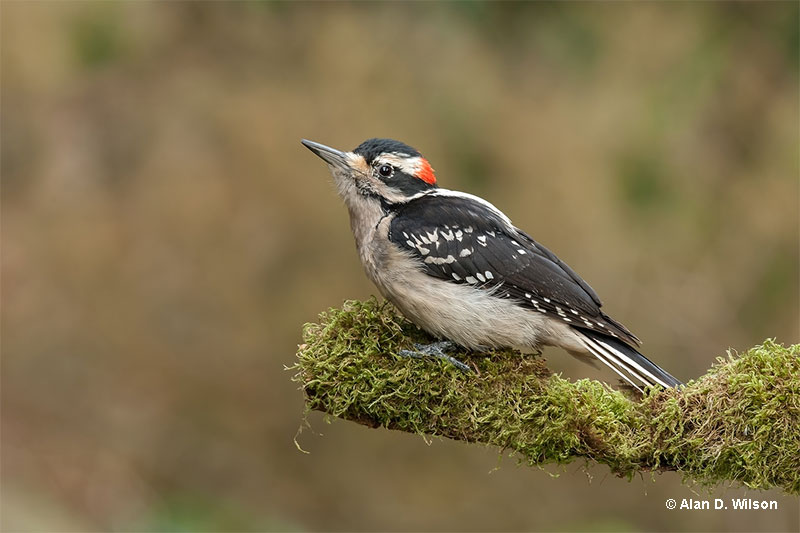
© Alan D. Wilson
Scientific name: Dryobates villosus
Length: 9.25 inches
Weight: 2.3 ounces
Wingspan: 15 inches
Song: “Qquechichichichichichicchichic!”
Hairy Woodpeckers are medium-sized, black and white woodpeckers with long, straight beaks. They have a white patch on their back and a black and white tail with unmarked, white outer tail feathers.
Both sexes look very similar but males have a small, bright red spot on the back of their head. Young birds have a dull red patch on top of their heads.
These woodpeckers mainly feed on insects, other small creatures, and a variety of seeds and fruit. They forage by pecking into bark and picking berries and other fruit from branches. In areas with big, mature trees, Hairy Woodpeckers are also regular visitors to bird feeders.
The Hairy Woodpecker nest in tree cavities. This species lives in parks and woodlands with mature trees in Alaska, much of Canada, and in most of the USA, including Connecticut.
They are absent from southern Florida and arid parts of the American Southwest.
Key Identifications:
- Medium-sized, black and white woodpecker with a long straight beak and unmarked, white outer tail feathers.
- Picks insects and fruit from bark of big trees, also eats seeds at feeders.
- Nests in tree cavities.
- Often calls and gives a sharp and explosive “Peek!” and a longer rattle, “Qquechichichichichichicchichic!”.
They need woodlands and parks with big trees and dominate the smaller Downy Woodpecker at feeders. This species gets its name from fine, hair-like feathers on its back.
Birds of Connecticut – Frequently Asked Questions
How many species of birds are in Connecticut?
In total, 452 bird species can be found in Connecticut. This is the number of bird species that have been seen in the state.
What is the white water bird in Connecticut?
The white water bird in Connecticut could be the Great Egret. This large, white wading bird is commonly seen in the state’s coastal habitats.
What is the bright red bird in Connecticut?
The bright red bird in Connecticut is probably a Northern Cardinal or a Scarlet Tanager. The cardinal is one of the most common birds in the state, and Scarlet Tanagers are also commonly seen in wooded habitats.
What Connecticut black bird has a blue head?
A Connecticut black bird with a blue head could be an Indigo Bunting or a Common Grackle. Both of these species are common birds of Connecticut and can show black plumage with a blue-colored head.
What bird is yellow with a black head in Connecticut?
In Connecticut, a yellow bird with a black head is probably a Baltimore Oriole (which happens to be the state bird of Maryland) or a male American Goldfinch. Both of these common bird species can have yellow plumage and black on their head. The Evening Grosbeak is also dark yellow with a dark head but it is rare in the state.
What is a black bird with red wings Connecticut?
The black bird with red wings in Connecticut is the Red-winged Blackbird. This species is a common bird of open and wetland habitats.
Are there cranes in Connecticut?
Yes, there are cranes in Connecticut. The Sandhill Crane is occasionally seen in wetland habitats in various parts of the state. Great Blue Herons also live in Connecticut and are sometimes referred to as “cranes” but they are in the heron family.

